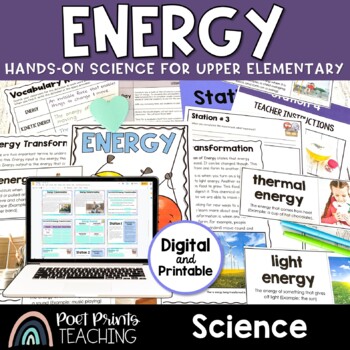Forms of Energy and Energy Transfer
- PDF
- Google Apps™

What educators are saying
Also included in
- Plan your grade 4 science lessons with the click of a button! This is a discounted BUNDLE of four science units for elementary. All 4 science units align to the BC Big Ideas for Grade 4 Science and have been aligned to the NGSS.Which Science Units does this discounted bundle include?Biomes and AdaptPrice $29.99Original Price $38.00Save $8.01
Description
Explore the ten forms of energy with this (DIGITAL and printable) hands-on science unit for elementary. This complete unit includes everything you need to teach about the forms of energy and how energy is transferred from one form to another. Students will have hands-on opportunities to see energy transfer in action in this unit that also includes integrated reading, writing, station-based and project-based learning activities.
Each lesson in this unit includes a complete teaching guide with detailed set-up instructions and thorough lesson plans. Let us do the planning for you!
What's included in this Forms of Energy science unit?
- Day-By-Day Teachers Guide - A daily lesson breakdown for using all parts of this resource in ten 45-60 minute science lessons! The planning is all done for you. ✏️
- Introductory Forms of Energy Worksheets - Introduce students to the concept of energy using the pages in this section of this packet. Choose the page(s) in this section that work best for your class. Have students brainstorm what they already know about the forms of energy and do some simple research to discover a little bit more. Try doing this part in pairs or small groups!
- Vocabulary - Vocabulary word wall cards using the major vocabulary from this energy unit. Vocabulary words in this unit include the terms: energy, kinetic energy, light energy, sound energy, thermal energy, elastic energy, nuclear energy, chemical energy, magnetic energy, gravitational energy, electrical energy, energy input, energy output, The Law of Conservation of Energy, energy transformation.
- Vocabulary Hunt - Place the vocabulary cards around the room and conduct a ‘vocabulary hunt’ where students are asked to search around the room to find the definitions for their vocabulary words!
- Vocabulary Buddy Game - Students will practice defining the unit vocabulary words in a fun, active game.
- Non-Fiction Reading - 4 pages of non-fiction reading passages with corresponding reading response worksheets. Non-fiction reading passages are titled "What Is Energy" and "Energy Transformation"
- Lesson: Energy Bounce - Introduce the concept of energy transformation to your students with a bouncy demonstration using a basketball and a tennis ball. Then, students will out some energy transformation of their own by bouncing energy between marbles!
- Student-Led Learning Stations: Energy Transformation - In this lesson, students will rotate through four student-led stations. At each station, students will complete an activity and determine what the energy input and output are.
- Project-Based Learning: Energy Machine - In this project, students will design and build their own machine that transforms energy from one form to another! After creating a detailed blueprint, they will gather materials from home and build a prototype to show the class.
This unit also includes a DIGITAL, Google Slides version of all student activities. These are perfect to complete as paperless assignments or for virtual learning.
If you are working remotely or distance learning, I suggest teaching the lessons to your students via video (Zoom, Google meet, uploaded videos) and giving students a chance to work on any independent projects or assignments at home. Or, try completing them together while on a video call!
All BC Big Idea Grade 4 Science Units are on the way! Expect them all by Fall 2021. Units that are currently available:
This unit covers British Columbia, BC Big Ideas for Grade 4
- Big Idea: Energy can be transformed.
- Content: Energy has various forms
- Content: Energy is conserved
- Content: Devices that transform energy
NGSS
- 4-PS3-2. Make observations to provide evidence that energy can be transferred from place to place by sound, light, heat, and electric currents.
- 4-PS3-3. Ask questions and predict outcomes about the changes in energy that occur when objects collide.
- 4-PS3-4. Apply scientific ideas to design, test, and refine a device that converts energy from one form to another.






